Every recruiter knows time-to-hire and quality-of-hire directly impact business growth. In fact, the right AI recruiting software can cut screening time in half, reduce bias in shortlisting, and seamlessly plug into ATS and interview platforms.
But with so many AI-driven options, each claiming unique strengths. How do you decide which one to trust?
This guide compares the eight best AI recruiting software for enterprises, highlighting features, pricing, and use cases. Whether you’re hiring software engineers at scale or evaluating fairness in assessments, you’ll walk away knowing which solution delivers the ROI you need.
Must-Have Features in Your AI Recruiting Software
AI recruiting software varies widely in quality and capability. The best platforms stand out by offering features that save time, reduce bias, and provide real value to hiring teams.
Here are the must-have features to look for.
- Bias detection and fairness benchmarks: Look for AI recruiting tools that provide audit trails and fairness reporting. Enterprise buyers should be able to test for gender, ethnicity, or age bias in AI-driven shortlisting and ensure compliance with global hiring standards.
- Deep ATS and workflow integrations: AI recruiting software should not work in isolation. Ensure it integrates natively with ATS platforms like Greenhouse, Lever, Workday, or SAP SuccessFactors. Smooth handoffs between sourcing, screening, and interviewing save hours for recruiting teams.
- AI-powered technical assessments: For hiring software engineers, your AI recruiting platform should go beyond resume parsing. Look for AI-backed assessments that auto-evaluate coding, full-stack projects, and even subjective answers. This ensures fair scoring without recruiter bias.
- Proctoring with AI defense against ChatGPT and extensions: With generative AI tools easily accessible, proctoring must go beyond webcams. Smart Browser technology, tab-switch detection, AI-powered snapshots, and audio monitoring help ensure test integrity. Even more critical is extension detection, which prevents candidates from misusing tools like ChatGPT, InterviewCoder, and Cluely during technical hiring.
- Skill-based candidate matching: Modern AI recruiting software uses skills graphs to match candidates to roles. Instead of keyword matching, these systems infer adjacent skills (e.g., Python proficiency indicating capability with Django) to expand and refine talent pipelines.
- Candidate experience insights: The best platforms track candidate engagement, drop-off rates, and interview satisfaction. AI-powered analytics highlight friction points in the funnel, helping recruiters optimize both experience and conversion rates.
These capabilities set apart enterprise-ready AI recruiting platforms from lightweight tools. Next, let’s see how the top players stack up.
📌Also read: The Mobile Dev Hiring Landscape Just Changed
Quick Overview Table: AI Recruiting Software Tools
This table provides an at-a-glance comparison of the leading AI recruiting software, breaking down key features to help you find the best tool for your hiring needs.
Top 8 AI Recruiting Software Tools Explained
With so many platforms claiming to be the best, it is hard to know which AI recruiting software is truly worth your time. Below, we break down the top 8 tools, highlighting their key features, pricing, and use cases so you can compare with confidence.
HackerEarth
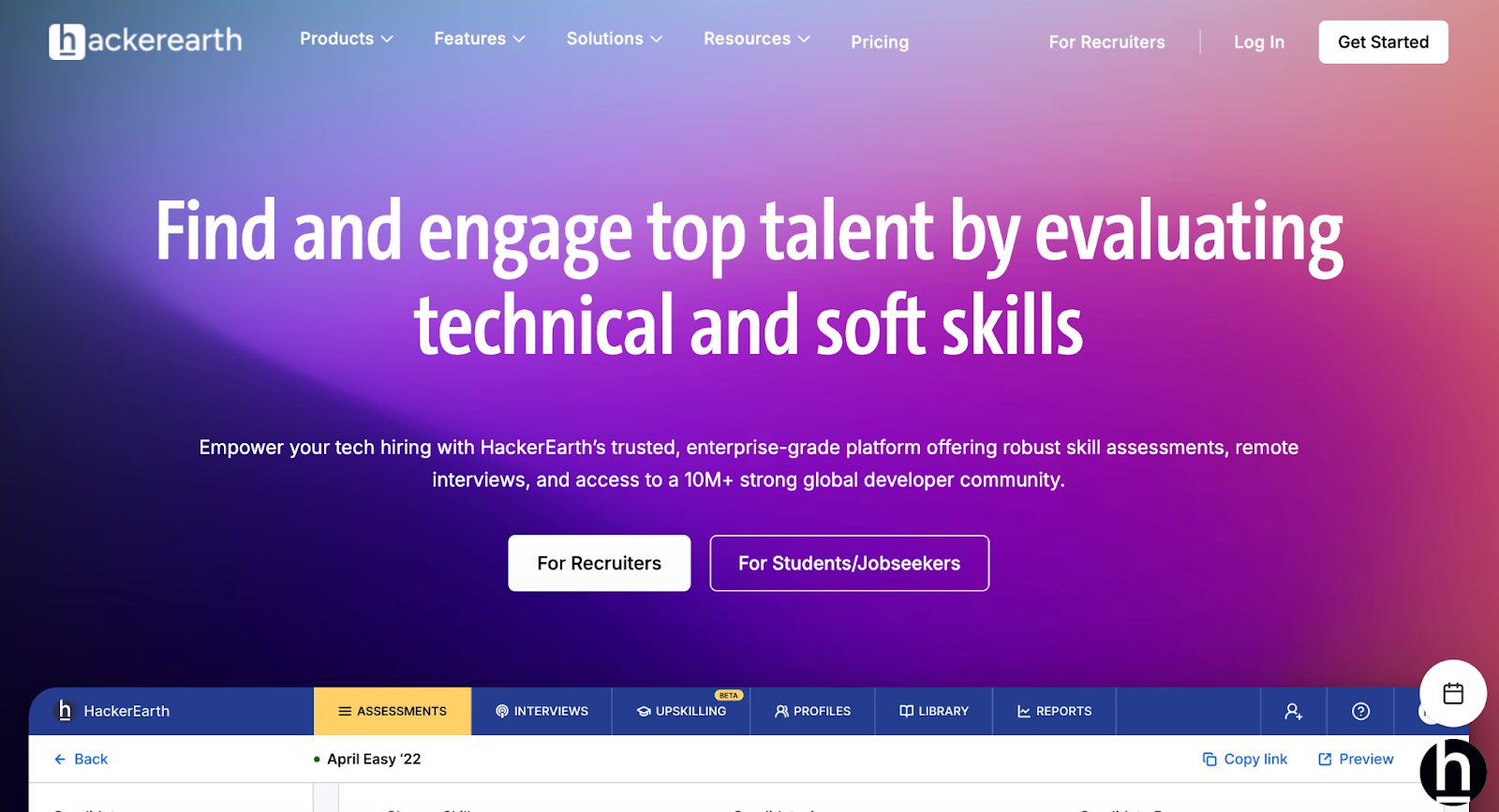
HackerEarth is a comprehensive AI-powered recruiting platform built to help enterprises streamline technical hiring at scale. Compared to other lightweight testing tools, HackerEarth combines deep skill assessments, advanced proctoring, and collaborative interviews into a single ecosystem. Its library of over 36,000 questions spanning 1,000+ technical and domain-specific skills gives recruiters flexibility to assess candidates on coding, full-stack projects, DevOps, machine learning, data science, and more.
What sets HackerEarth apart is its focus on security and fairness. The platform’s proctoring capabilities go beyond webcam monitoring to include Smart Browser technology, AI-powered snapshots, tab-switch detection, audio monitoring, and even extension detection to prevent misuse of tools like ChatGPT, InterviewCoder, Cluely, etc. This makes it highly trusted for campus hiring, lateral recruitment, and high-stakes enterprise assessments.
HackerEarth also supports auto-evaluated subjective questions, a feature missing in most competitors, enabling recruiters to assess communication, problem-solving, and domain knowledge without manual review. For engineering teams, it integrates SonarQube-based code quality scoring, which evaluates code not just for correctness but also for maintainability, security, and readability.
On the interviewing side, FaceCode, its collaborative coding and video interview platform, offers real-time proctoring, automated summaries, and candidate behavior analytics. Combined with 15+ ATS integrations and enterprise-grade scalability (supporting unlimited concurrent candidates), HackerEarth ensures seamless workflows for recruiters managing bulk or niche hiring. With 24/7 global support, dedicated account managers, and SLA-backed guarantees, HackerEarth positions itself as one of the most robust AI recruiting software platforms for enterprises in 2025.
Key features
- 36,000+ questions across 1,000+ skills, including coding, SQL, ML, and full-stack projects
- AI-powered proctoring with Smart Browser, audio monitoring, extension detection, and tab-switch alerts
- Auto-evaluated subjective questions for domain-specific skills
- Code quality scoring powered by SonarQube
- Use FaceCode for proctored video interviews with transcripts, collaborative coding, and automated summaries
- Seamless ATS integrations with 15+ platforms, including Greenhouse, Lever, and Workday
Pros
- Highly scalable with no concurrency limits, ideal for campus and bulk hiring
- Deep technical assessment coverage with bias-resistant scoring
- Rich analytics, including skill benchmarking and candidate behavior insights
- 24/7 global support with SLA-backed commitments
Cons
- There are no non-advanced plans. The basic plan comes with advanced procroting features so may not be suited for companies who are looking for cheaper stripped down plans.
Pricing
- Growth Plan: $99/month per user (10 credits)
- Scale Plan: $399/month (25 credits)
- Enterprise: Custom pricing with volume discounts and advanced support
📌Suggested read: The 12 Most Effective Employee Selection Methods for Tech Teams
HireVue
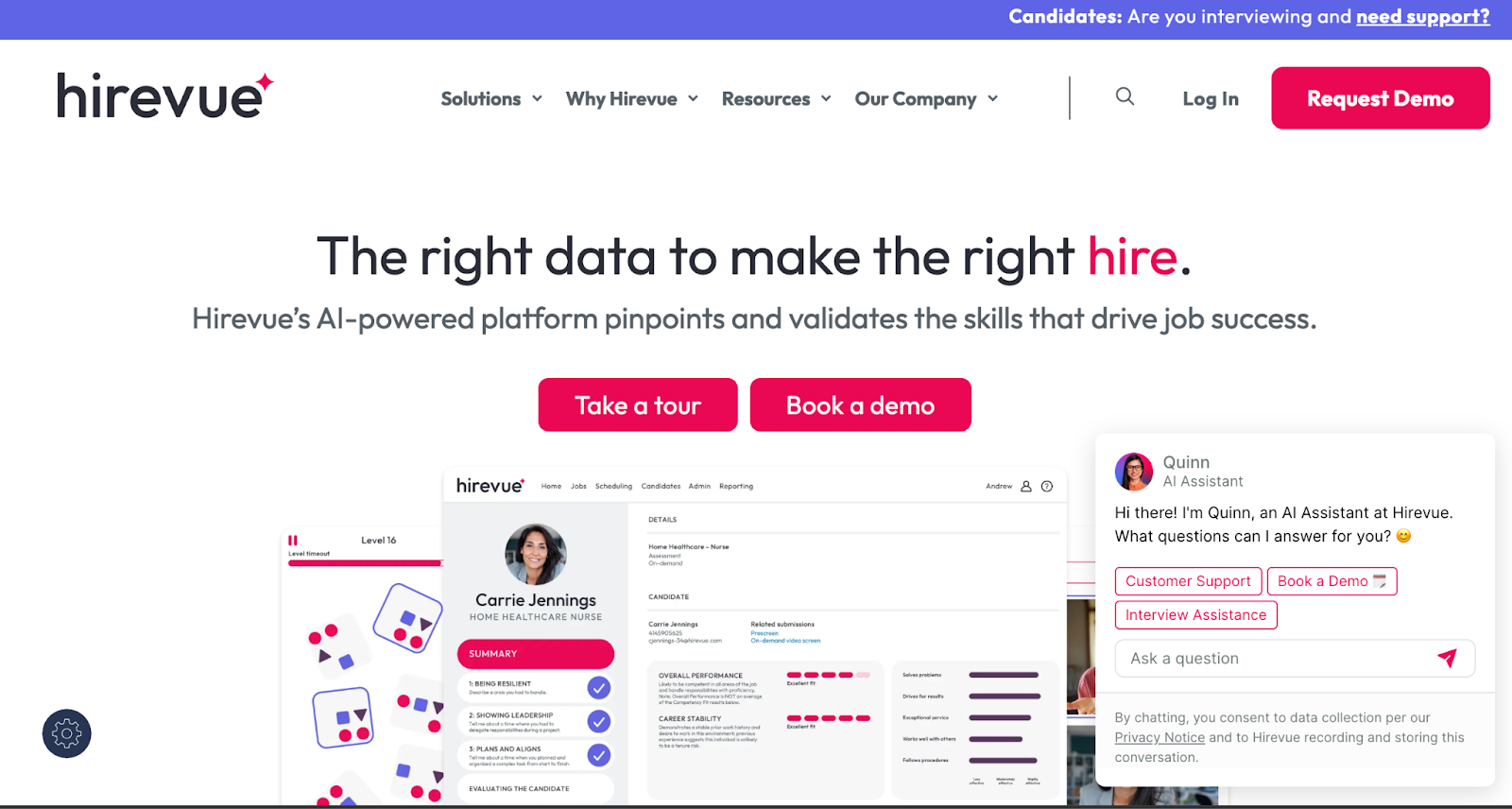
HireVue is best known as a pioneer in video interviewing software, now expanded into AI-powered hiring assessments. The platform helps enterprises streamline high-volume hiring with one-way and live video interviews, structured assessments, and automated candidate scoring.
Following its acquisition of Modern Hire, HireVue now offers a more comprehensive suite that includes science-based “Virtual Job Tryouts” and predictive assessments, making it particularly strong for organizations with large, distributed candidate pools.
Key features
- One-way and live video interviewing with AI evaluation
- Pre-employment assessments, including Modern Hire’s Virtual Job Tryouts
- ATS integrations with major enterprise systems
Pros
- Easy-to-use video interviewing platform with clean UI
- Strong for high-volume hiring and structured assessments
- Candidates can record responses at their convenience
Cons
- Users frequently face scheduling issues with HireVue
Pricing
- Custom pricing
Vervoe
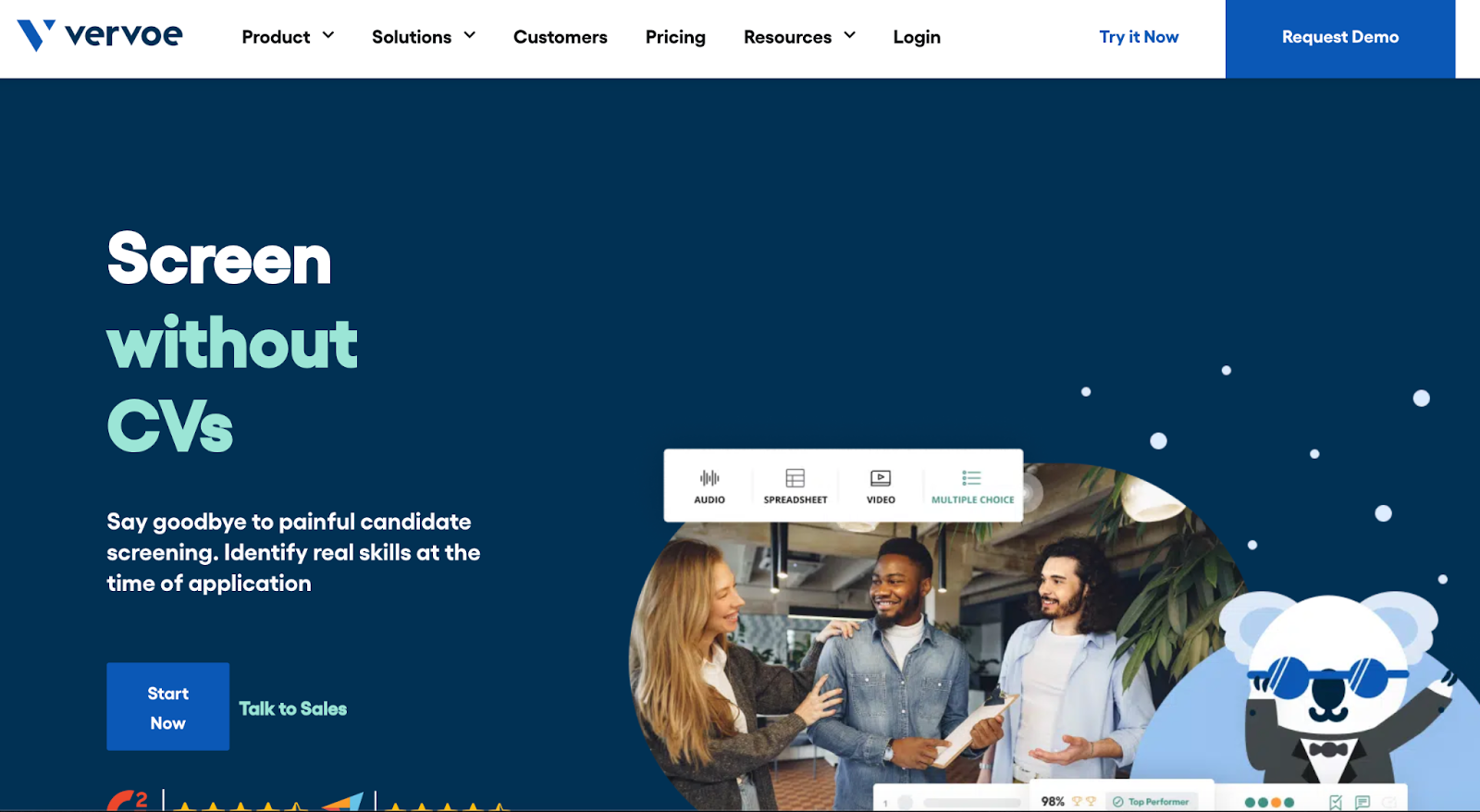
Vervoe is an AI-powered skill testing platform designed to help recruiters move beyond resumes. It specializes in simulating real-world job tasks through customizable assessments and then uses machine learning to grade responses and rank candidates automatically.
While its question library is smaller than enterprise-focused platforms, Vervoe stands out for highly engaging, role-specific simulations and strong candidate experience. Its scoring models aim to reduce bias by focusing on skills demonstrated rather than background.
Key features
- AI-driven auto-grading and ranking of candidates
- Candidate engagement metrics and feedback
- ATS integrations with platforms like Greenhouse, Lever, and Workable
Pros
- Engaging assessments that mirror real work scenarios
- Strong AI-driven ranking that saves recruiter time
- Easy-to-use interface with high candidate satisfaction
Cons
- Limited question library (around 110+ questions by default)
Pricing
- Free (7 days)
- Pay As You Go: $300 (10 candidates)
- Custom: Contact for pricing
*Pay As You Go is charged as a one-time payment
Xobin
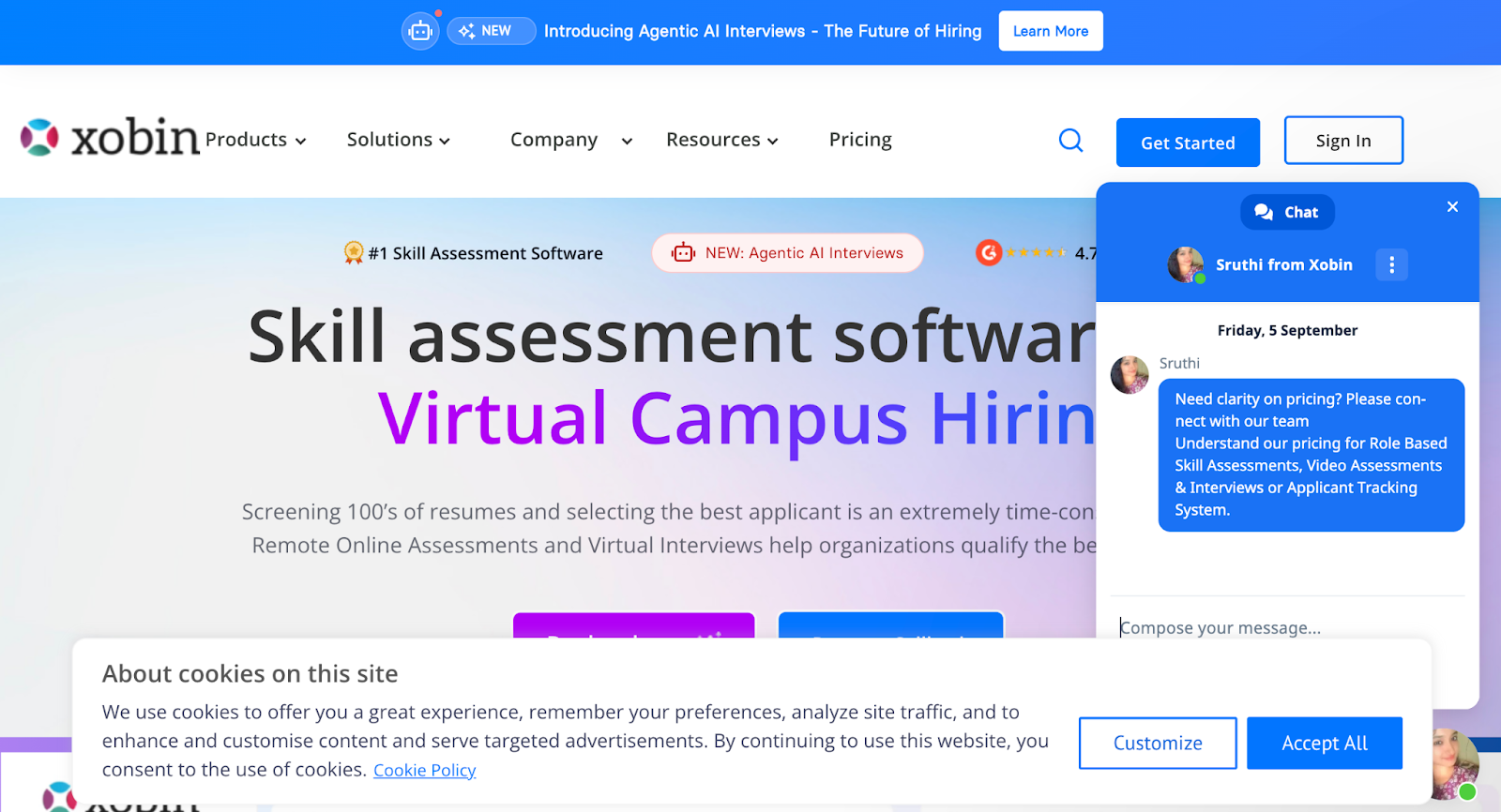
Xobin is an online assessment platform that blends affordability with a user-friendly interface, making it attractive for companies looking for a simple yet reliable screening tool. With support for both technical and non-technical roles, Xobin has gained traction with mid-sized organizations and startups needing a cost-effective alternative to enterprise solutions.
It is best suited for companies that prioritize ease of setup and affordability over complex workflows.
Key features
- Prebuilt tests, job-role–based assessments, and custom test creation
- ATS integrations with popular recruiting platforms
- Video proctoring with manual verification
Pros
- Affordable with high customer satisfaction ratings
- Strong UI and easy test setup
- Reliable performance with dedicated support
Cons
- Fewer ATS integrations than other enterprise-grade tools
Pricing
- 14-day free trial
- Complete Assessment Suite: Starting from $699/year
Glider AI
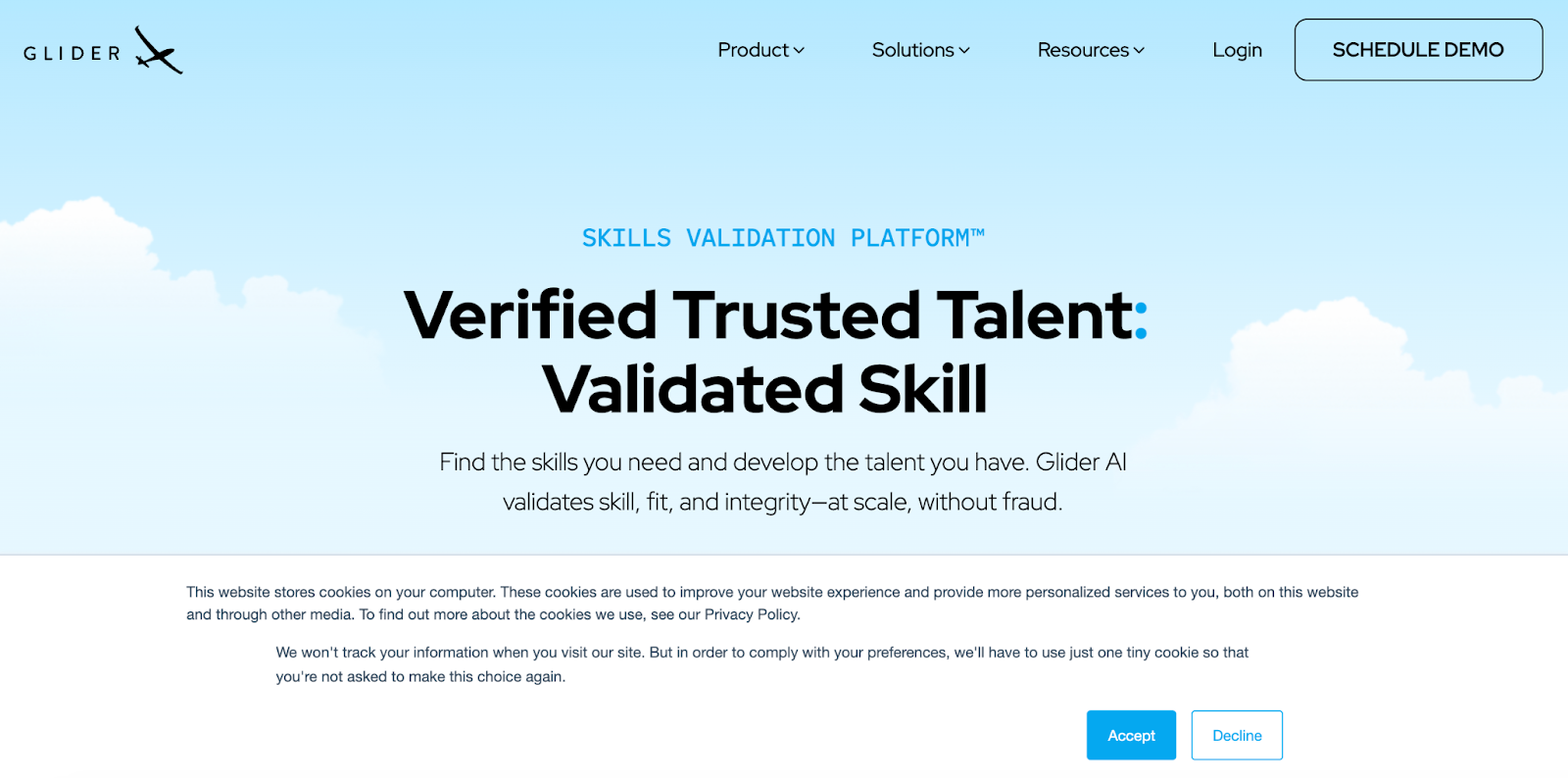
Glider AI is a skill intelligence and talent quality platform that integrates assessments, coding interviews, and anti-fraud measures into a single solution. It is especially popular with staffing firms and enterprises that need scalable hiring while maintaining trust and compliance.
The platform supports technical and non-technical assessments and is known for its seamless integrations with ATS, VMS, and HRMS systems, making it a favorite for organizations that run recruitment at scale or through staffing suppliers.
Key features
- Advanced anti-fraud proctoring (identity verification, AI monitoring)
- Integrations with ATS, HRMS, and Vendor Management Systems
- Analytics dashboards with candidate benchmarking
Pros
- Excellent anti-cheating and fraud detection features
- Strong customization for enterprise hiring
- High ratings for support and analytics on G2
Cons
- Some users cite a learning curve with advanced features
Pricing
- Custom pricing
📌Related read: How Candidates Use Technology to Cheat in Online Technical Assessments
Pymetrics
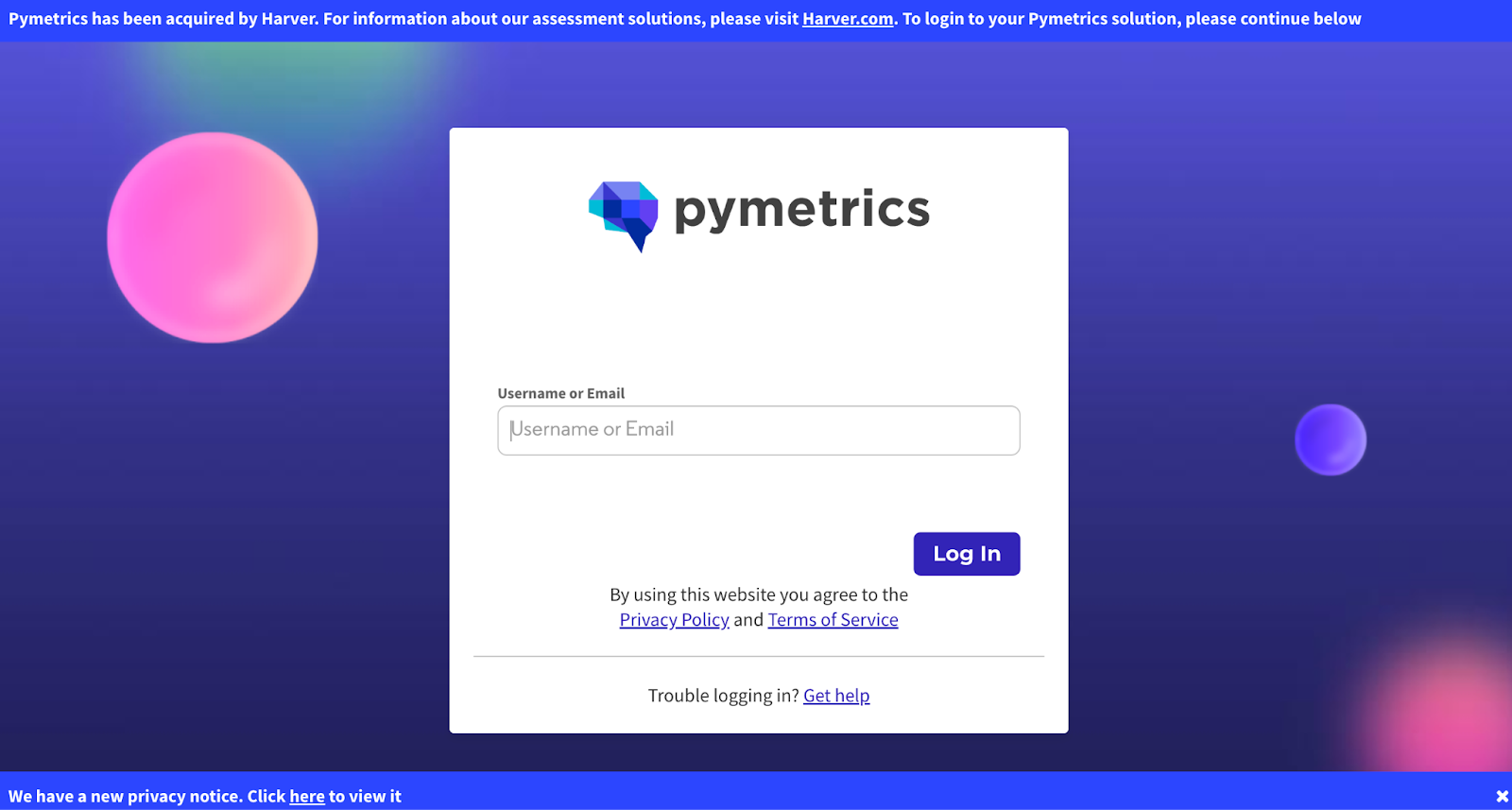
Pymetrics, now part of Harver, is a neuroscience-driven hiring platform that uses gamified assessments to measure soft skills such as risk tolerance, attention, and decision-making. Its standout feature is its focus on reducing bias in early-stage hiring through AI-powered candidate matching that maps results to job profiles.
This makes it especially popular among organizations that want to diversify their hiring funnel and identify potential rather than just past performance.
Key features
- Gamified neuroscience-based assessments
- AI-driven candidate-job matching models
- Bias reduction and fairness monitoring
Pros
- Engaging candidate experience that feels less like a test
- Helps diversify hiring and identify hidden talent
- Strong for early-stage screening and soft-skill evaluation
Cons
- Results are sometimes perceived as less reliable for experienced professionals
Pricing
- Custom pricing
Modern Hire (A HireVue Company)
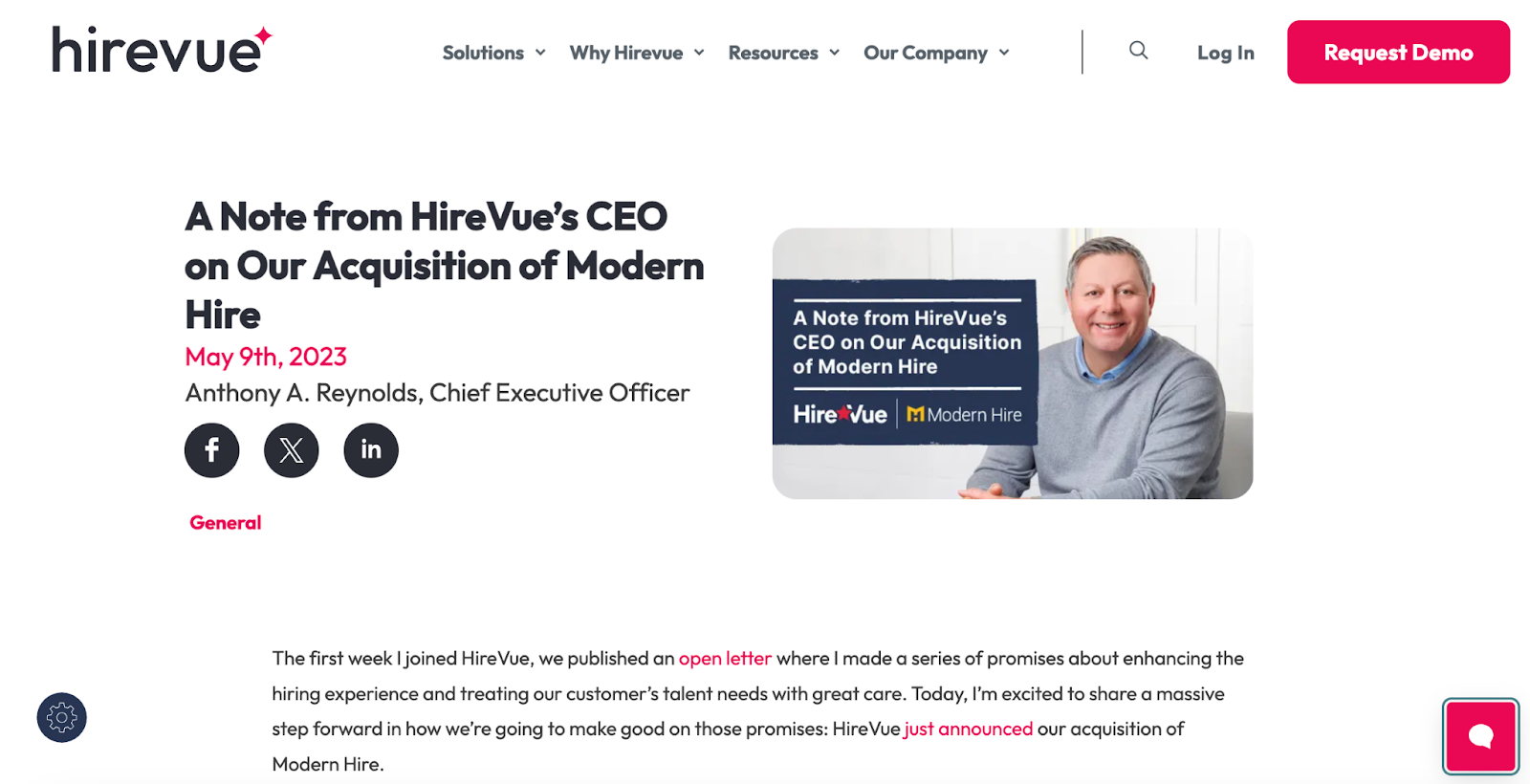
Modern Hire, now integrated into HireVue’s suite, was initially built as a science-backed hiring assessment platform. Its flagship feature, the Virtual Job Tryout, uses job simulations to evaluate candidates’ abilities in realistic scenarios. This makes it particularly effective for roles where structured assessments can predict job success better than resumes or unstructured interviews.
Since the acquisition, Modern Hire’s tools have been rolled into HireVue’s broader offering, combining predictive assessments, video interviews, and AI-driven scoring into one enterprise solution.
Key features
- Predictive analytics based on job success benchmarks
- Structured interview guides with AI scoring
- Seamless integration with HireVue video interviewing suite
Pros
- Highly validated, science-based assessments
- Strong predictive value for frontline and high-volume roles
- Smooth integration with HireVue’s video interviewing tools
Cons
- Requires enterprise-scale budgets and longer implementation cycles
Pricing
- Custom pricing
Eightfold AI
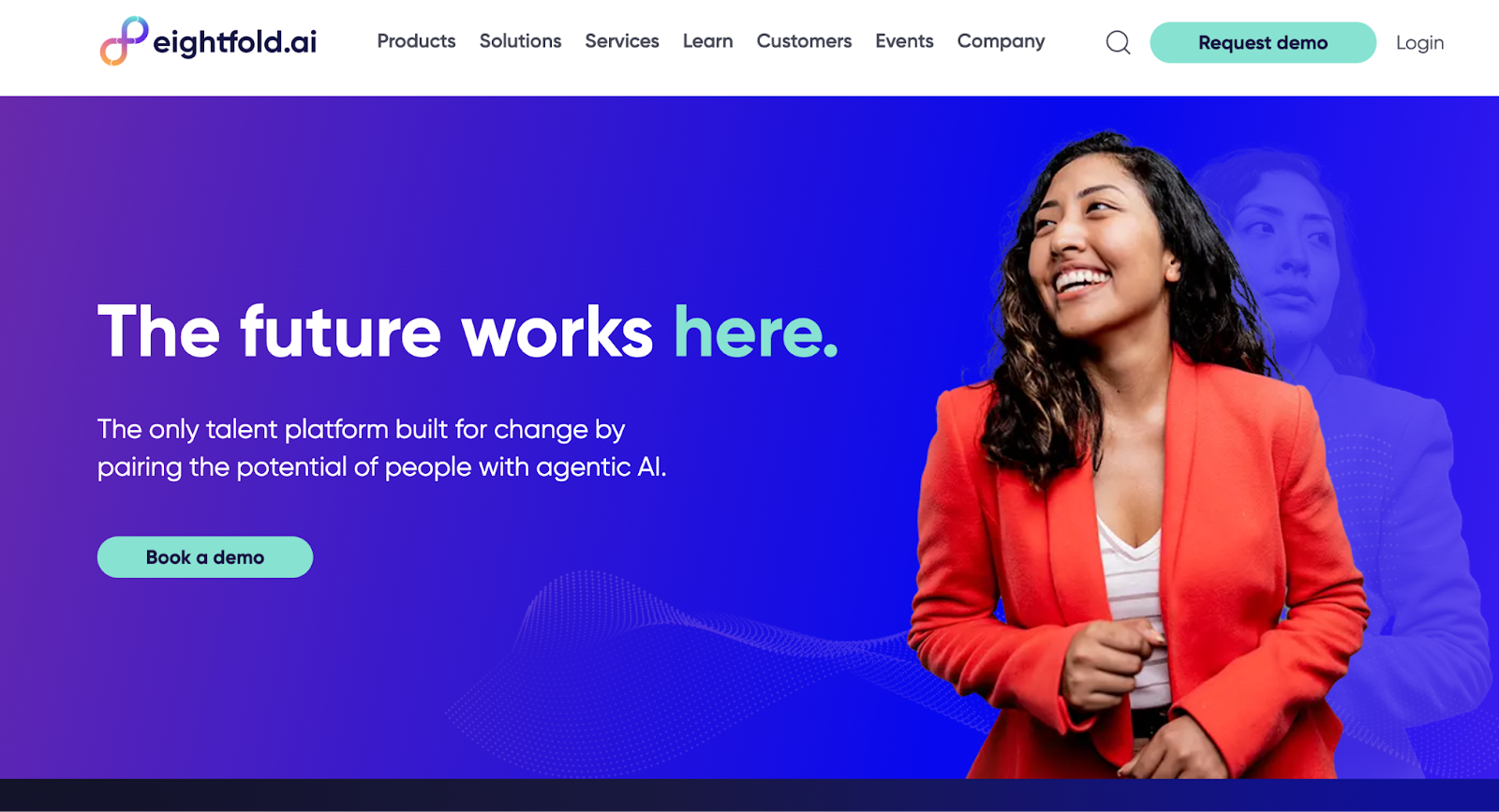
Eightfold AI positions itself as a Talent Intelligence Platform rather than a standalone assessment tool. Its AI-powered “Talent Intelligence Graph” analyzes billions of career profiles globally to provide candidate-job matching, internal mobility insights, and workforce planning.
Eightfold AI helps enterprises find new external talent, and it also identifies reskilling and upskilling opportunities for internal employees. This dual capability for both external and internal recruiting makes it one of the top AI tools for hiring software engineers.
Key features
- AI-driven job matching based on a global skills graph
- Talent CRM for sourcing and nurturing candidates
- Internal mobility and reskilling recommendations
Pros
- Comprehensive talent intelligence covering sourcing, recruiting, and internal mobility
- Clean UI with advanced analytics and predictive insights
- Strong fit for enterprises with global hiring needs
Cons
- Limited native assessment capabilities
Pricing
- Custom pricing
Choosing Smarter AI Recruiting Software in 2025
The landscape of AI recruiting software in 2025 is both diverse and competitive. Platforms like HireVue and Modern Hire excel in high-volume video interviewing, while Vervoe and Xobin deliver affordability and ease for SMBs. Similarly, tools like Glider AI and Pymetrics focus on fraud prevention and bias-free assessments, and Eightfold AI stands out for talent intelligence and workforce planning.
However, if your goal is to hire technical talent at scale with fairness, accuracy, and enterprise-grade reliability, HackerEarth leads the pack. With a 36,000+ question library, SonarQube-powered code quality scoring, AI-driven proctoring, and FaceCode’s collaborative interviews, it delivers an end-to-end solution that competitors struggle to match. Add to that unlimited scalability, seamless ATS integrations, and 24/7 SLA-backed support, and HackerEarth becomes the clear choice for enterprises looking to future-proof their hiring.
If you’re ready to cut screening time, ensure fairness, and scale your hiring pipeline confidently, the next step is simple! Schedule a demo with HackerEarth and see how AI can transform your recruiting outcomes.
FAQs
What is the best AI tool for recruitment?
The best tool depends on your hiring needs. For enterprise technical hiring, HackerEarth is a good option for AI-driven assessments and proctoring.
How is AI used in recruiting?
AI automates repetitive tasks like resume screening, candidate matching, and skills evaluation. It also powers proctoring, bias detection, and predictive analytics, helping recruiters make faster, fairer, and more data-driven hiring decisions at scale.
How do I test AI tools for bias?
Check if the vendor provides fairness benchmarks or audit reports across demographics like gender, ethnicity, and age. Run pilot programs comparing human and AI outcomes, and verify compliance with EEOC, GDPR, and emerging AI regulations.
What’s the ROI of using AI recruiting tools?
Enterprises typically see reduced time-to-hire, improved quality-of-hire, and lower attrition. ROI also comes from reduced manual screening costs, stronger compliance, and better candidate experience, which collectively strengthen employer branding and workforce efficiency.



































